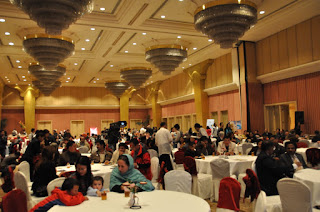The Disappearing Satra Culture in Majuli Island, Assam
Within the belly of the mighty Brahmaputra river lies a massive cluster of islets that emerged through different water channels. Known as Majuli, it is the largest inhabited freshwater island in the world with a community that is relatively isolated. As erosion rips its banks every year, Majuli island is rapidly disappearing, washing away villages and displacing residents. The currents are so powerful as to reshape the island from its original 1,200 km² size to 400 km² today. As Majuli island is slowly being eaten away, studies show that it is likely to be submerged under water in the next 15-20 years.
 |
| Motorised ferries and boats are the only means of reaching Majuli. |
The Kumar people in southeastern Majuli who make handcrafted pots from river clay are one of the affected communities. Since their livelihood depends on earthen pots, they live close to the river’s edge. Making pots requires clay procured from pits 30 feet deep from the ground along the banks of the river. Women shape the glutinous clay by hand, dry it in the sun and bake it in a furnace. The furnace is fired with bamboo, banana leaves and driftwood. This craft is so tedious and it takes them several months to fill a boat with hundreds of pots. Men then sail the boats up and down the river to exchange pots for paddy which is the staple food of the inhabitants of this island.
Every year dozens of people are forced to leave this island as monsoons steadily make the river swell. From 2001, over 3,000 families were forced to relocate after flood waters swallowed large chunks of their land. In 2016, Bhakatram Das moved from his home at Samaguri village to Baghgaon after an erosion by Brahmaputra submerged his house and land. This was the family’s third relocation since 2008. His bamboo and banana plants, which sustain his family of four, were all gone.
 |
| Erosion affected Majuli resident Bhakatram Das outside his newly constructed house |
A few hundred metres away, Gereli Das was also forced to build a new residence with wood and bamboo. She, her husband and daughter were among dozens who lost their lands to erosion and were forced to shift. In the floods of 2016, more than five dozen villages were wiped out from the island, including several places of historical significance.
 |
| A wall made of bamboos is being erected at Majuli’s southern tip to control erosion. |
As the river continues to deform the island, a handful of its historical satras or monasteries stand on unstable grounds. There are many satras across Assam but Majuli has the biggest concentration of them and is considered the seat of Assam's Vaishnavite culture. This Vaishavite teaching was originally brought to Assam in the 15th century by Srimanta Sankardeva, a devotee of Lord Krishna and Lord Vishnu. Known as a movement to reshape religious and social norms, the Vaishnavite teachings bring together people from different castes through theater, dance, intellectual teachings and discussions.
 |
| Auniati is the oldest Satra of Majuli which houses a museum with ancient artifacts |
The tradition of Satradhikar (guru) and Bhakats (monks) tradition still exists in Satras. The most prominent satra known as Auniati brings in young boys from economically backward families to teach them rituals of evening prayers and music classes. Nitul Dutta, a bhakat (monk) of the Auniati Satra says that these boys start living in Auniati satra at the age of 8, integrate with monks of different ages and spend their life in celibacy. I was fortunate to meet monk Nitul Dutta and the boys. As I extended my hand to offer a hand shake, they moved away from me and I was not allowed to touch any part of their body. This was part of their strict practice in celibacy.
 |
| Monks walk the hallways of Auniati Satra |
Each Satra is known for a special craft. The Auniati satra makes hand fans and the Chamaguri satra makes intricate masks with sun-dried bottle gourd and the bark of the betel nut tree. The Kamalabari satra makes fine wooden boats. Samaguri satra, the world-renowned mask-making monastery, has been making masks for over 350 years. Starting from 2000, Hem Chandra Goswami, satradhikar (monk) of Samaguri satra has experimented with several techniques to reduce weight of the masks so that they are easier to make.
 |
| Introduction of movable jaws and eyes allowed masks to be more expressive. |
Goswami’s masks are made with bamboo, cloth and a mixture of cow dung and earth with movable jaws and eyes. These masks can only be bought at Samaguri ‘satra’ to prevent crass commercialization and takes 4-5 days to complete. Goswami’s masks was displayed in London’s British Museum during an exhibition called ‘Krishna in the Garden of Assam’ in 2016.
 |
| Masks used in traditional plays, one of Majuli’s cultural heritage, on display at Samaguri ‘satra’. |
The first satra was built on Majuli in the 15th century and 64 more were installed to promote art, culture and spirituality. These monasteries are considered to be treasure troves of religious scriptures, books on music, dance, literature, philosophy, painting and even medicine. The bhakats (religious devotee) take active part in engaging the community in these varied art forms, producing well known artists in national and international platform.
The floods in the Brahmaputra threaten to submerge this river island in Assam which is home to Satra Culture. The subsequent soil erosion have brought down the number of Satras in the river island. Today, only 22 satras remain.
The floods in the Brahmaputra threaten to submerge this river island in Assam which is home to Satra Culture. The subsequent soil erosion have brought down the number of Satras in the river island. Today, only 22 satras remain.



Comments
Post a Comment